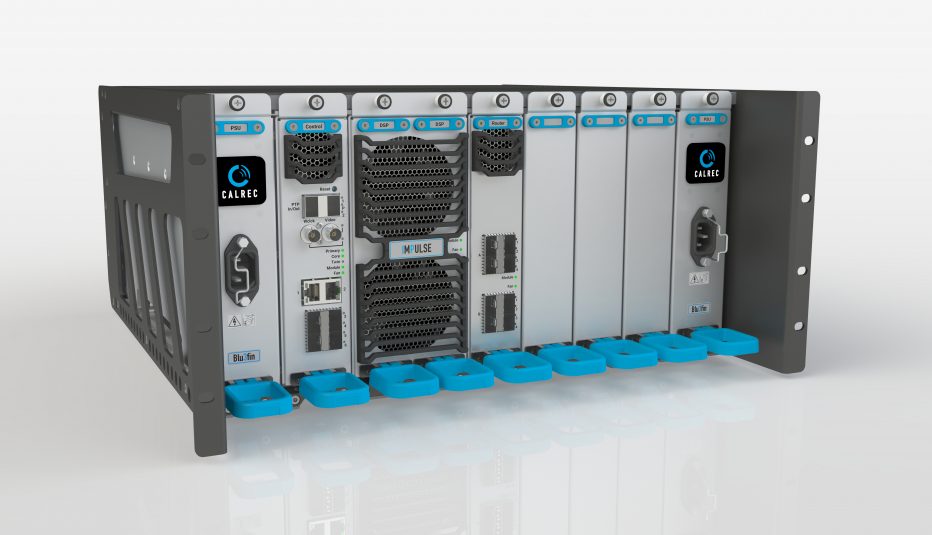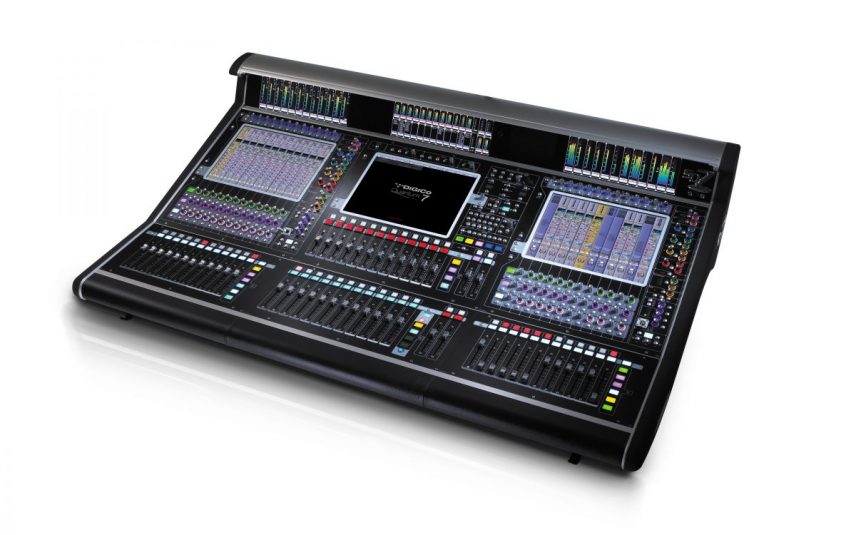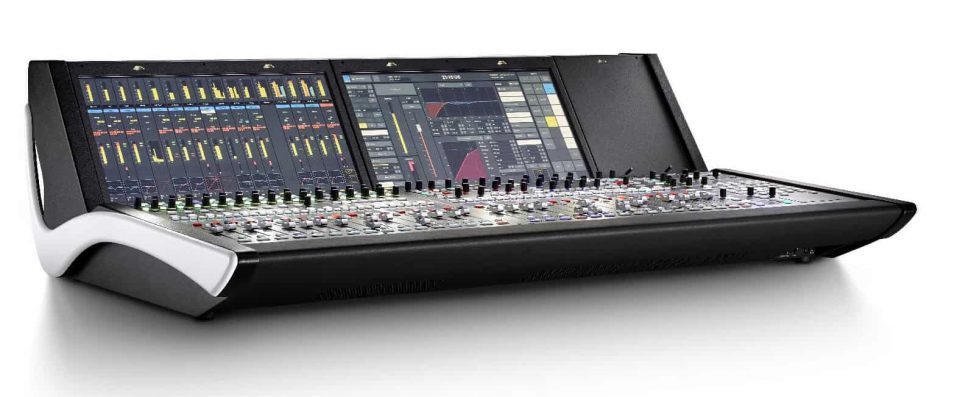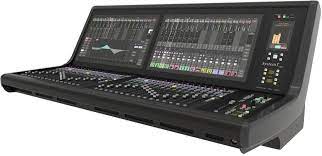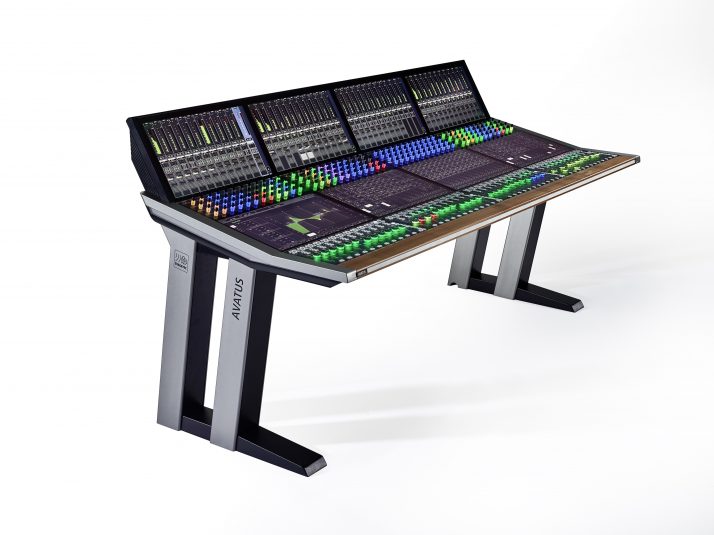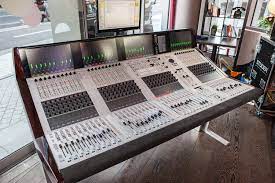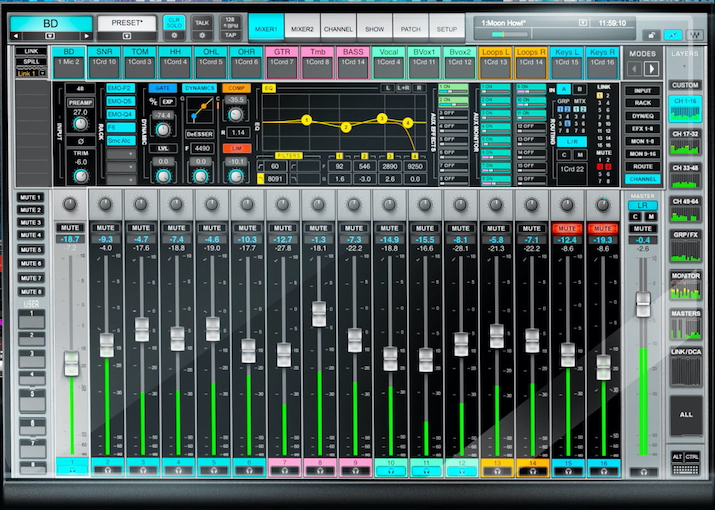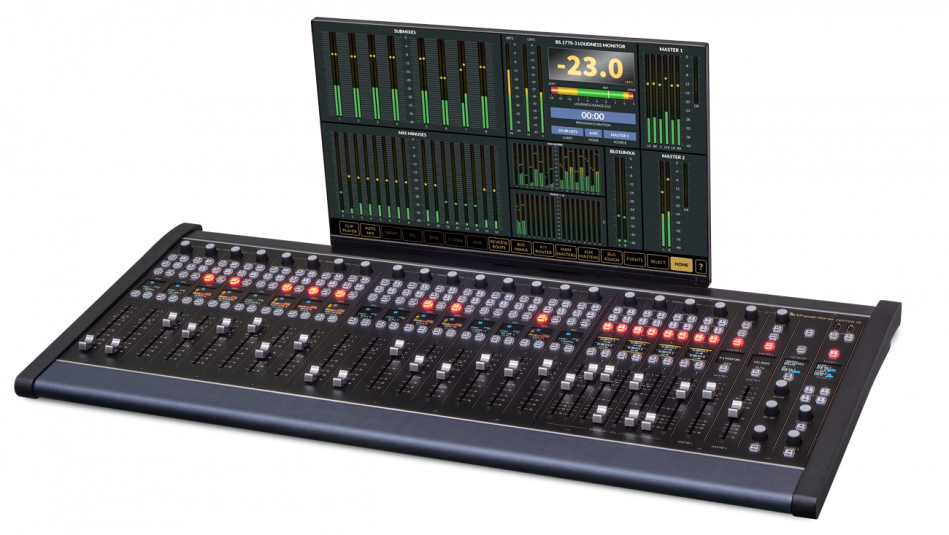Tech Focus: Audio Consoles, Part 2 — Remote Products Offer Increased Diversity
Demand grows for variety in sizes, functions
Story Highlights
Remote audio-mixing consoles for broadcast are still a relatively rarefied category at the high end of the market, but there’s more diversity within the group, thanks to increased demand for various sizes and functionalities. Here’s an overview of the leading contenders.
Click here for Tech Focus: Audio Consoles, Part 1 — Next Generation Heads to the Cloud.
Calrec
Calrec’s Assist web GUI is implemented on the Apollo, Artemis, and Type R consoles to provide remote control from distant locations. It’s also available on Calrec’s RP1, which continues to provide full broadcast capabilities at a remote venue from an established studio environment.
The company’s IP-based ImPulse core has a native SMPTE 2110 IP backbone and a defined upgrade path for broadcasters to transfer to IP infrastructures. ImPulse is compatible with existing Apollo and Artemis control surfaces and is NMOS-compliant, which is critical to the unified workflow of products from different manufacturers. For broadcasters already producing live content in immersive formats over platforms like MPEG-H and Dolby Atmos, ImPulse also provides 3D immersive path widths and panning, with full monitoring and metering, height, and 3D pan controls.
In addition, Calrec’s modular Type R console is increasingly being used for virtualized production. www.calrec.com/
DiGiCo
The Quantum 7B delivers the functionality, audio performance, and scale required to handle the largest productions. Quantum 7 features three large-scale FPGAs working in unison. Inside the Quantum engine, up to 2,000 channels can be transported across 688 processing paths at 96 kHz. New GTX ports run at 6.6 GHz, and simple two-wire connections ensure the fastest possible data speeds. Standard channel processing across both inputs and outputs includes channel delay, DiGiTuBe, single and multi-channel presets, dual insert points, hi- and lo-pass filters at 24 dB/octave, four-band parametric EQ (eight on outputs) with band curve selection and Dynamic EQ on each band, DiGiCo’s DYN 1 (compressor, de-esser, or multiband compressor) and DYN 2 (gate, compressor, or ducker). Mustard Processing is a fully integrated suite of additional processing that can be assigned to any strip to boost the mix with a range of modeled preamps, vintage dynamics units, and EQ sections. The master section incorporates 48 gangable 48-band graphic EQs, 48 stereo effects, and 36 control groups (VCAs). In addition, 128 buses are assignable as mono/stereo groups or auxiliaries; a 48×48 output matrix, dual solo buses with True Solo, and LR/LCR/5.1 master bus are available for even deeper configurability. With the inclusion of patented Nodal Processing, processing can be applied to any node on the auxiliary section of the console, allowing engineers to send unique processing on each send from single or multiple channels. www.digiconsoles.com/
Lawo
Lawo’s mc² mixing consoles — the mc²96, mc²56, and mc²36 — focus on IP-based broadcast, AV, and live-production scenarios and are available in multiple configurations for at-home productions, flypacks, OB trucks, and large production facilities in on-premises, WAN-distributed, and hybrid deployments. Thanks to open standards like ST 2110, RAVENNA, and AES67, remote-production capability comes as standard.
The mc² consoles integrate with Lawo’s HOME management platform for IP-based media infrastructures, which is designed to connect, manage, and secure all aspects and instances of live production. In addition to automatic discovery and registration, HOME provides centralized services for engineers’ swift and effective interaction with their tools, whether Lawo’s or other vendors,’ that support the HOME API.
The mc² audio-production consoles are powered by the A__UHD Core audio engine as the heart of a dynamic and distributed audio-production system. Distributed production involving two or more audio engineers working from adjacent or geographically distanced locations can be leveraged over secure WAN connections, regardless of whether operators prefer a data-center–style resource-pooling strategy or a globally scattered network of A__UHD Core units. Software licenses are stored on USB dongles and can be downloaded for seamless transfers from unit to unit. The Pool DSP license allows operators to split the 1,024 available DSP channels across multiple consoles in a range of configurations for physical, virtual, and headless (automation-driven) control surfaces.
A complete range of IP-based audio edge devices is also available from Lawo. The A__stage series accommodates users in search of high-channel-count I/O in a variety of formats (analog, AES3 digital, and MADI); the single-format A__line devices are usually used in flypacks, mobile remote setups, and locations where only a few sources and destinations are used. The company’s PowerCoreRP is a remote-production solution for mc² audio consoles with built-in modular I/O, DSP, and IP-streaming capabilities. Rear-panel bays allow users to install as many as eight I/O cards for additional audio inputs/outputs and interfacing with MADI and Dante networks. The PowerCoreGateway is a modular audio stagebox allowing professionals to software-upgrade to RP functionality when they need additional DSP power.
All Lawo consoles support automation and studio/remote-management applications, including Ember+ and the vendor-agnostic VSM Virtual Studio Manager IP broadcast-control system. For scripted remote productions, the Mix Kitchen approach allows A1 engineers to work from home or somewhere on the road. www.lawo.com/
SSL
System T is a fully networked broadcast-audio–production environment, across an IP-based, network-native control and audio infrastructure. It has a highly configurable architecture and a range of hardware and software control interfaces, which can be distributed anywhere across a network; included among them are specific offerings for flypack systems and remote-production installations. Control interfaces include the flagship S500 modular large-format console and the flypack-ready S500m, which delivers the same feature set as the S500 in a form factor more than 25% lighter and with turnkey flight-case solutions available. The compact S300 provides 16+1, 32+1, or 48+1 faders, providing the power and versatility of System T in a streamlined console layout that remains intuitive for operators with a wide range of skill levels. The Tempest Control Rack (TCR) is suited to environments where the power of a broadcast-audio mixer is required but a traditional console is not, such as automated broadcast environments and mobile/remote broadcast applications. Individual remote fader tiles and PC-based control software complete the System T control-interface offering. Any surface variant can connect to either Tempest Processor Engine: a T25 (256 fully processed paths at 48 kHz) or a T80 (800 fully processed paths at 48 kHz). In addition, up to three consoles or control interfaces can access a single or fully mirrored redundant pair of Tempest processor engines. System T’s inherent AoIP infrastructure provides inbuilt Dante, AES67, and SMPTE 2110-30 audio-transport capability. A range of interfaces are available to connect to existing I/O infrastructure. solidstatelogic.com
Stage Tec
AVATUS is an innovative, high-performance IP audio-mixing console well-suited for applications in broadcast and represents an effective compromise between tablet computers and the well-established AURUS desk. The console offers color-coding for control elements, such as encoders and faders, and user guidance without deep hierarchies. Its 21-in. FHD multi-touch screens provide a flexible user interface; a fixed center section is no longer necessary. Removable PoE-powered metering screens underline the modularity of the AVATUS system. AVATUS will be available in various hardware versions. IP technology allows surfaces to be added and assigned to consoles during runtime via the web GUI and change configuration/layout according to the project requirements. A dual-user mode enables two engineers to work on the same console independently.
The AVATUS flagship multi-format production console is available in four surface configurations with 12-96 faders and per-setup–scalable core resources featuring 218-822 channels and 128-32 mix buses (capacities at 48 kHz; 96 kHz is supported with lower channel count). Working in 5.1 and 7.1 surround, stereo, and mono can be done simultaneously through multiple separate bus configurations. Different downmix/upmix capabilities are available both in the consoles and in the NEXUS network. With Waves Integration, plugins can be connected directly to the AVATUS scene-automation system. Thanks to the AES67/RAVENNA connection and Dante interfaces from NEXUS, AURUS Platinum can be integrated into IP networks.
Stage Tec’s NEXUS audio network offers interfaces to all standards and covers the current IP formats with the latest RIF67/XFIP boards (JT-NM Tested). The boards are based on DirectOut’s AES67.IO module and support the AES67/RAVENNA protocol. They also comply with ST 2110-30 and 2022-7 standards, which support interoperability in audio networks. On the control side, NEXUS offers an Ember+ gateway via the NEXUS XACI board in addition to a proprietary system. www.stagetec.com/
Studer
Now part of Evertz Microsystems, Studer’s Vista line of Infinity-powered broadcast mixing consoles continues to comprise the Vista V and X. They retain the Vistonics and FaderGlow user interface from previous versions, providing control of up to 1,100 audio DSP channels and more than 6,000 inputs and outputs. At the heart of the system is the Infinity ST DSP cores, which use CPU-based processors to provide huge numbers of DSP channels for large-scale, high-resolution audio processing and mixing. Offering significant advantages, CPU processing provides a scalable system, faster development of new signal-processing designs, larger channel counts, full-system redundancy without a single point of failure, and the possibility of running third-party algorithms. The latest Infinity ST series of DSP engines has a simplified lineup comprising two models; both the ST550 and the ST1100 provide natively at the core ST 2110-30 and A-Link high-capacity digital fiber audio interfaces with scalable 6,000+ I/O. The Studer high-density modular I/O system can be used to break out the A-Link or ST 2110-30 connections to numerous standard analog, digital, and video interfaces. The ST 2110-30 and A-Link interfaces also provide direct audio connection to many standard analog, digital, and video interfaces. With this integration, Studer Vista can operate as a standalone audio console or as part of a fully featured and comprehensive audio/video infrastructure. evertz.com/solutions/studer/
Waves
Cloud MX Audio Mixer is designed for cloud broadcast environments, delivering pristine audio, high-precision mix control, and creative processing capabilities with full Waves plugin integration — all in a scalable, remotely operated, broadcast-ready cloud workflow.
Broadcasters and media organizations can add state-of-the-art audio mixing and processing to their flexible professional cloud-based workflows, thanks to Cloud MX’s double-precision 32-bit-float mixing engine, augmented by Waves’ portfolio of cloud-licensed audio plugins.
Cloud MX is NDI-compatible, fitting easily into NDI-based environments with easy patching and routing of NDI audio streams. It is also easily deployed on AWS, facilitating integration with cloud production systems. Cloud MX makes it easy to scale productions with any number of audio mixers, without the operational costs involved in shipping, maintaining, or scheduling on-premises gear and personnel.
All Cloud MX packages come with cloud-licensed Waves eMo plugins (eMo D5 Dynamics, eMo F2 Filter, and eMo Q4 Equalizer), which form the mixer’s channel strip for a fast, efficient workflow. Audio capabilities can be expanded even further by upgrading to Cloud MX Audio Mixer Plus, with 11 extra cloud-licensed plugins, such as the Primary Source Expander for automatic mic-bleed elimination, the Renaissance Vox vocal compressor, the surgical F6 Floating-Band Dynamic EQ, MaxxBass, and the L2 UltraMaximizer. Upgrading to Cloud MX Audio Mixer Premium adds more than 150 cloud-licensed plugins, including the Dugan Speech plugin for real-time automatic mixing of multiple mics. www.waves.com/
Wheatstone
The WheatNet-IP audio network is an AES67-compliant AoIP system offering a wide selection of devices, software applications, and desktops as well as virtual mixing consoles. A new Layers software suite for remote applications supports backend audio processing, mixing, and streaming provisioning hosted on a server at the home studio and user-interface software for laptop, tablet, or other “glass” surface at the remote location. One Dell or HP server can serve multiple mixing, streaming, or processing instances over IP links connected by WheatNet-IP audio networking. Layers Glass software includes full-function virtual mixing with familiar buttons, knobs, and multi-touch navigation and menuing. WheatNet-IP supports SMPTE ST 2110 and NMOS discovery and offers a full line of AoIP interfaces and consoles for any application, from standalone virtual mixers and compact Tekton 32 console to the large-frame Arcus console. www.wheatstone.com/
